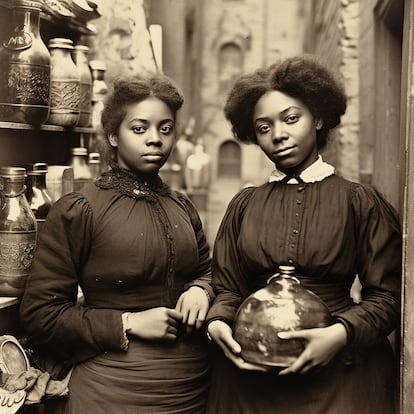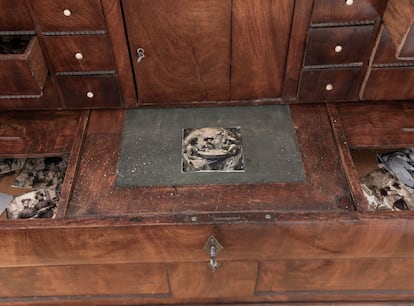A few weeks ago, the gold-plated dome of the Secession Building in Vienna was blackened. The artist Susana Pilar Delahante Matienzo (Havana, 40 years old) had covered its 3,000 gilded laurel leaves with women’s stockings and, on the very roof of the temple designed by Klimt in 1897 to house his subversion against the Academy, proclaimed that her personal history, the history of black women in Cuba, has been plundered.
It was the first intervention of his artistic proposal for the Secession, the oldest contemporary art center in the world, which exhibits the Beethoven Frieze by Gustav Klimt. It was dismantled after two weeks, the duration of the permission of the Austrian heritage authorities, and public access was not authorized. He presented it together with a performance scheduled for August 27 and an exhibition of 1,750 images generated by artificial intelligence (AI), which can be visited until September 8. Like the characters created by a fiction writer or a filmmaker, Susana Pilar has conceived a catalogue of visual fictions with black women in unusual situations.
A work against the erasure of history. “My ancestors were not slaves, they were enslaved,” says the artist. “I seek to dignify black women and their representation during the era of slavery and colonization. I use AI as a tool to create historical images that streamline that imaginary. My ancestors were not just slaves, they had culture, language, development, knowledge, resources. Much of that was destroyed, but thanks to the oral heritage of generations we preserve it.”
Thieves of stories
As a descendant of Africans and Chinese forcibly displaced to Cuba, Susana Pilar One day, she went to the historical archives of the city of Matanzas. She found no documents. No one had written them down. “Only the descendants of Spaniards have that information. The records were inventoried by white people. The archives do not reflect my ancestors: they reflect those who colonized them. Making them invisible is a way of preserving power, of maintaining domination. I decided to fill with my imagination the void of what was stolen from me in my family history and my personal history, and to accompany it with oral histories. For me, it is a way of defending my heritage and showing that I am aware that I have a history that was eliminated.”

In their performances, Susana Pilar is used to using her own body. Her great role model is the artist Ana Mendieta (“Is she often imitated? It is an honour that this happens. Her work is being recognised, something that does not happen in Cuba. She opened the way for performances“). In Endurancethe video she prepared for the DuSable Museum of African American History in Chicago in 2019, sees her trying to stay upright in front of a compressed air machine. “You don’t see the air, the violence is invisible. The body is resisting something. Like this invisible racism that can be so subtle in Europe. I was thinking about my own experience as a black woman.”
In his work for Vienna, Achievement (Achievements), the artist, who currently lives and works in the Netherlands, opted for a new technology to create protagonists of a story without a visual record. The images, printed on photographic paper and displayed in the Secession’s Graphic Cabinet in Biedermeier-style antique furniture, show women who have achieved success, not just freedom, wearing elegant clothes dating from the 16th to the 19th century. “There is a lot of selection and editing work,” says Susana Pilar, who used the Midjourney program. “In the prompt [el texto proporcionado para describir la imagen que se quiere generar con el programa de IA] I would write, for example: ‘Portrait of an African-American woman in a Victorian dress who laughs at the camera and has bought her freedom.’ When I wrote black woman and the date and a place, the result was always the same: pain and slavery.”
Debate on art
His first inspiration was Berlin-based photographer Boris Eldagsen, who submitted an AI-generated image to the World Photography Organisation competition and won. After renouncing the prize, Eldagsen launched the debate he sought to spark with his entry: Are AI-generated images photography?
Susana Pilar does not doubt it, yes. “The result of my work with AI is the same as that achieved with the creation of multiple exposure images. It is a multi-exposure photograph. I did something similar in my work Happens, unlimited access (2003), a series of double exposure photographs where I superimpose my body on the camera with the bodies of Cuban women who had suffered physical violence and were unable to tell about it.”
Ramon López de Mántaras also has no doubts, but in the opposite sense. Asked about this by EL PAÍS, the founder of the Artificial Intelligence Research Institute of the Higher Centre for Scientific Research (CSIC) and one of the pioneers in AI in Spain, explains: “It has nothing to do with photography. Etymologically, photo means light. That is, photographing would be something like ‘writing with light’ and what we get is a capture of reality through a device that captures and processes light. An image generated from a text is an image synthesized from an algorithm. It is a process that has nothing to do with photography.” And he adds: “Generative AI is a generator of fakes. In the case of ChatGPT, it fakes people [hace creer al usuario que está hablando con una persona] and in the case of Midjourney and similar apps, it fakes photographs, since it makes the user believe that what they are looking at is a photograph.”

In addition to the controversy over the art of photography, there are also lawsuits over copyright infringement facing programs such as Midjourney. There is still no ruling or regulation, but a group of artists has sued these technology companies for appropriation of content in their database.
In her conceptual art proposal, Susana Pilar openly exposes her creative process (including a catalogue raisonné and her own biography) and pushes the motto engraved in gold letters on the façade of the Secession to the limit (“To each era its art, to art its freedom”). The great challenge posed by AI image generators is the certainty that we are facing a visual scenario in which it will be difficult to distinguish the real from the fictional. Next year, in April, she will star in a performance at the Thyssen Museum in Madrid. “There was a Spanish colonial rule in Cuba. We will see if I can address it there.”
All the culture that goes with you awaits you here.
Subscribe
Babelia
The latest literary releases analysed by the best critics in our weekly newsletter
RECEIVE IT
#Artificial #intelligence #breaks #Klimts #temple #denounce #erasure #black #women